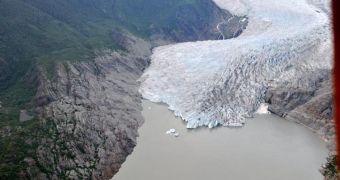Alaskan glaciers and their surrounding land arguably produce some of the most beautiful sights in the world, with limbs of ice spiraling downwards from mountaintops. Researchers swarm to various locations every single year, taking measurements, collecting core samples, looking for fossils, or establishing the impact that global warming and climate change is having on the region. But a group of investigators has over the past couple of years visited the region for an entirely different reason, namely to determine the types and concentrations of the various chemicals the glaciers release.
When ice caps and glaciers form, they tend to absorb numerous chemicals from their respective locations. This is most obvious with snow left on the side of highly-circulated roads, which becomes black in a very short time. Scientists use this fact to determine the composition of the planet's atmosphere millions of years ago, and to learn when massive eruptions or asteroid impacts occur. This is all well and good, but problems appear when large amounts of ice begin to melt, releasing large amounts of peculiar chemicals in the air or in underground water streams. This is what is now happening in the Arctic, where the permafrost is releasing the methane it captured a long time ago.
One of the ways to assess the complexity and dangers of the chemicals glaciers let go is through injection experiments. Researchers need to go up to the top of the ice, find streams formed by liquid water, and then dump, or inject, a salt solution and several solutions containing nutrients into the runaway waters. By measuring the concentrations that these chemicals have at the bottom of the glaciers, the science teams are able to determine precisely the proportion in which these chemicals are absorbed, or pass straight through the glaciers. The data collected downstream is then cross-referenced to information obtained from samples collected above the injection points.
This line of work is tremendously important, as it can yield clues to many natural phenomena, including why glaciers melt, why they retreat so fast, how they affect the environment, what chemicals they contain and in what concentrations, and so on. These data can then by inserted into more complex computer models that would be used to reduce the level of uncertainty associated with existing simulations on the future of the planet. With the effects of global warming bound to wreak havoc among the world's ices, knowing about its potential effects is being half-prepared to mitigate them.

 14 DAY TRIAL //
14 DAY TRIAL //